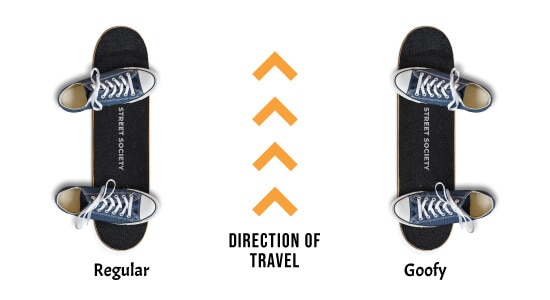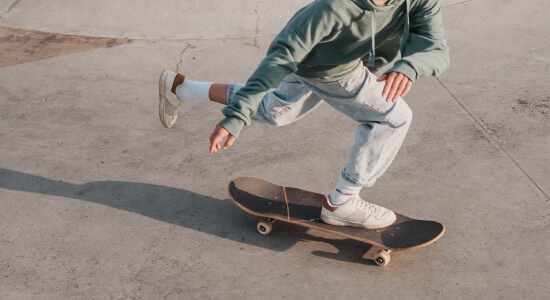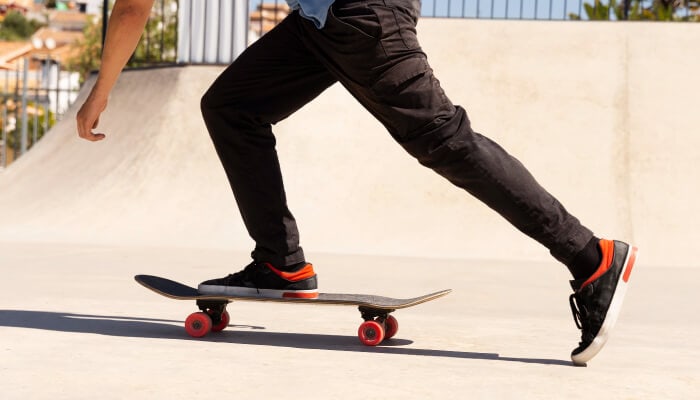Have you ever gazed in awe at a skateboarder’s graceful journey down the street and imagined yourself carving through the urban landscape with the same finesse? If you’re a newcomer to the world of skateboarding, then consider this your initiation into the exhilarating realm of skating – learning how to push on a skateboard.
While it may appear deceptively simple, mastering the art of pushing off is the first step to becoming a skilled skateboarder. It’s the foundation upon which you’ll build your repertoire of tricks and maneuvers. So, if you’re ready to embark on this exciting journey, let’s take that crucial push and roll into the skateboarding world together.
Understanding Skateboarding Basics
Before diving into how to push on a skateboard, becoming familiar with the broader world of skateboarding is essential. The sport originated in the early 1950s in California, birthed by surfers looking to “surf” the sidewalks when the waves were flat. This activity, initially dubbed “sidewalk surfing,” eventually evolved into what we now know as skateboarding.
At the heart of skateboarding lies the simple act of standing on a board and propelling yourself forward. This activity, known as pushing, is the foundation of all skateboarding tricks and maneuvers. Mastery of pushing is essential for any aspiring skateboarder.
Determining Your Stance

Before you can start pushing, you need to determine your natural stance. Skateboarding has two primary stances – regular and goofy.
- Regular Stance: If you’re more comfortable with your left foot forward and pushing with your right foot, you have a regular stance.
- Goofy Stance: If your right foot is forward and you push with your left foot, your stance is considered goofy.
Neither stance is better or worse—it’s all about what feels most natural. To determine your stance, imagine running and sliding on a slick surface. The foot you instinctively put forward is likely your front foot when skateboarding.
Getting into Position

Now that you’ve determined your stance, it’s time to position your feet properly on the skateboard. Your front foot should be placed just behind the front set of screws on the skateboard, while your back foot should rest on the board’s tail.
When pushing, your front foot should face forward for maximum balance and support. After you’ve finished pushing and your back foot is back on the board, pivot your front foot so it’s perpendicular to the length of the board. This slight movement may take some time but will become second nature with practice.
The Art of Pushing: How to Push on a Skateboard
Skateboarding, the sport of rebels and adventurers, carries an unmistakable allure that transcends generations. It’s a symphony of freedom, self-expression, and adrenaline performed on four wheels. But before you dive headfirst into kickflips and ollies, there’s one fundamental skill that every skateboarder must master: pushing.
Pushing on a skateboard is akin to the fluidity of walking. With one foot confidently planted on the deck and the other propelling you forward, you glide through urban landscapes, streets, and skateparks. It’s the foundation upon which you’ll build your skateboarding journey, and like any skill, it deserves attention and refinement.
Finding Your Balance
Imagine taking those tentative steps as a skateboarder, much like a baby’s first steps in walking. The key to a successful push lies in maintaining your balance. As you step onto the skateboard and begin moving, the motion should be as natural as walking. But let’s break it down further.
As your back foot hovers over the ground, ready to propel you forward, it’s essential to distribute your weight correctly. Most of your weight should rest on the front foot that’s securely on the skateboard deck. This ensures stability and control as you push off and cruise. Keep your knees slightly bent and your body centered over the board to maintain equilibrium.
Pushing with Purpose
Now that you’ve found your balance, it’s time to focus on the pushing mechanics. The foot you use for pushing is a pivotal decision, especially for beginners. Here, we delve into the nuances of pushing with your back foot versus the controversial “mongo” push.
Pushing with your back foot is the gold standard for skateboarding. It allows for better control smoother transitions, and facilitates learning tricks down the road. Using your back foot to push, your front remains firmly on the board, ready to pivot or steer as needed. This technique seamlessly blends into other essential skateboarding skills.
On the flip side, the “mongo” push involves using your front foot to kick off. It might feel intuitive for beginners, but it comes with limitations. Pushing mongo can make it difficult to control the skateboard and hinder your mastering of tricks. Transitioning from mongo to the standard push can also be a challenging process.
Mastering the Push
Now that you understand the basics, it’s time to refine your pushing technique. Practice is the key to mastery, and here are some tips to help you along the way:
- Foot Placement: Ensure your front foot is positioned comfortably over the skateboard bolts perpendicular to the deck. Your back foot should rest on the ground, toes pointing forward.
- Pushing Motion: Use the sole of your back foot to push off the ground. Aim for a smooth, controlled push rather than a frantic kick. Imagine you’re giving the ground a gentle nudge.
- Balanced Stance: Maintain balance by keeping your knees slightly bent and your weight centered over the board. Avoid leaning too far forward or backward.
- Consistency: Work on developing a consistent pushing rhythm. This will help you maintain speed and control while cruising.
- Practice Makes Perfect: Dedicate time to practice pushing regularly. Whether it’s a casual ride to the store or a session at the skatepark, every push contributes to your growth as a skateboarder.
Perfecting Your Ride
Now that you know how to push and turn, the next step is to perfect your ride. Spend time riding your skateboard around your neighborhood or at a local skate park. This will help you get comfortable on your board and improve your balance.
Stopping Safely
Knowing how to stop safely is as important as pushing and turning. One simple method is to let your back foot drag on the ground until you slow down and eventually stop.
While this method is effective, it can wear down your shoes over time. Another method is the power slide, which involves shifting your weight quickly and turning your board sideways. This method can be tough to master, but it’s an effective way to stop quickly when traveling at high speeds.
Continue Practicing
The key to mastering how to push on a skateboard is practice. Work on your pushing, turning, and stopping techniques each day. As with any new skill, it’s normal to encounter challenges along the way. Don’t be discouraged if you don’t get it right away. Keep at it; you’ll soon be cruising around like a pro.
Joining the Skateboarding Community

Learning to push on a skateboard isn’t just about mastering a new skill—it’s about joining a vibrant and diverse community of skaters worldwide. As you progress in your skating journey, consider connecting with other skaters in your local community or online. They can provide valuable tips, support, and inspiration.
Celebrating Your Progress
Lastly, remember to celebrate your progress. Learning how to push on a skateboard is a big accomplishment. As you continue improving and learning new tricks, acknowledge how far you’ve come. Whether you’re skating for fun, fitness, or the sheer love of the sport, every step forward is a reason to celebrate.
Conclusion
In conclusion, the art of pushing is the cornerstone of skateboarding. It’s the first step on your journey to mastering this exhilarating sport. So, step onto your board, find your balance, and push purposefully.
Embrace the fundamentals, and soon, you’ll be carving through the streets with the confidence and grace of a seasoned skateboarder. Remember, skateboarding is about more than tricks; it’s about the joy of the ride itself.
